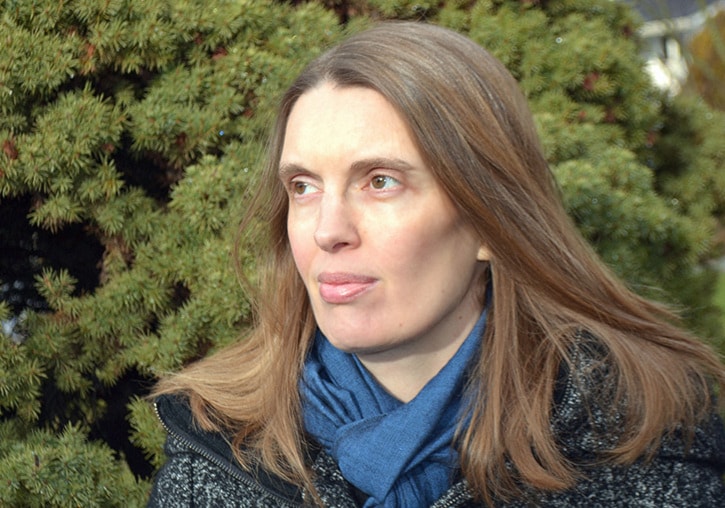The skeletal-like figures lie hunched as the giant tomb, the Mausoleum of Augustus, looms above.
Known for his fine detailed etchings of ancient Roman architecture, 18th century artist Giovanni Battista Piranesi often juxtaposed his work showing these opulent, classical buildings with that of decrepit-seeming human figures in the foreground.
This is no more apparent than in Piranesi’s series of etchings, The Views of Rome (Vedute di Roma), said Vernon author Hannah Calder, who has used both Piranesi and his figures as fictional constructs in her new book, aptly titled Piranesi’s Figures, published by New Star Books.
The tale of ruinous marriages and illicit love, Piranesi’s Figures hops from mid-century England to present-day Rome, and reaches back to 18th-century Rome to add the titular street urchins etched by Piranesi to its ensemble cast.
“Some of these figures look fairly ragged, as if they are homeless, and many are carrying sticks, as if they are lame,” said Calder. “I intentionally read very little about these figures because I wanted to interpret them in my own way.”
 The figures are not always easy to interpret in the book, but, in general, they represent the masses of people on earth right now that are destitute, homeless and migratory, added Calder.
The figures are not always easy to interpret in the book, but, in general, they represent the masses of people on earth right now that are destitute, homeless and migratory, added Calder.
“These people are grouped together in the book to reflect the way they are lumped together in the media,” she said.
Piranesi’s Figures is Calder’s second novel. Her first, More House, published in 2009, also explored illicit love in uncertain times.
“(Piranesi’s Figures) took me about eight years to finish, from having the idea to holding the book in my hand. It started out as a book about mentally ill artists in the early part of the 20th century and morphed into something quite different. Now it is a book about marriage, parenthood, infidelity, and loss,” she said.
Like Calder’s own life, the book is set in many different places and written through lived experience.
“Saying that, my presence in the book as ‘Hannah, the author’ is pretty tongue in cheek. I’m certainly not writing a memoir here, but there are a number of family stories, very brief ones, that drove this narrative from the beginning – one being the affair that my grandmother allegedly had with my grandfather’s adopted brother,” said Calder.
“That character, Hilda, also experiences the pain of infertility, something that I also experienced after the birth of my daughter.”
Born in the U.K., Calder moved to Canada when she was 15, and lived in Barcelona, Seoul, and Vancouver before returning to Vernon, where she now teaches English at Okanagan College.
Piranesi’s Figures is set in Margate, a seaside town on the southeast coast of England, as well as Heidelberg, Germany, London and Rome. There are also references to Canada, and particularly the Okanagan, in the book, said Calder.
“The book was written in scenes that were eventually stitched together. The scenes dictated what happened in the book rather than the other way around,” she said.
“What plans I had when I began were mostly all thwarted by the end. Reading the book was an experience of discovery for me and I found myself interpreting the book as if it had been written by somebody else.”
Although some of Piranesi’s characters get more “screen time” than others, they are presented as a makeshift team tasked with playing roles and engaging in dialogue.
“They are all aware that they’re in a book and they sometimes even discuss what this feels like and whether things are working out as they expected or hoped they would,” said Calder.
“There are three married couples in the book and an awful lot of affairs taking place, but it’s never quite clear if the affairs are real or not. In these relationships, there’s plenty of denial, paranoia, contradictory behavior, lies, and even humour.”
Besides Piranesi’s etchings, another major influence for Calder was the art of mentally ill patients collected by an early 20th century German doctor named Hans Prinzhorn (who is portrayed as Dr. Grebing in Piranesi’s Figures).
“As I progressed with the project, the Prinzhorn characters either merged with the Piranesi figures or they found their way into a collection of short stories I was simultaneously working on,” said Calder.
Other influences included Andrew Moore’s photographic exhibition, Detroit Disassembled; the expat experience during the Romantic era; a trip Calder took with her partner to Rome and Florence in 2007, and her disdain for the tourism industry and the people that, she says, mindlessly feed it.
“(There’s also) the resurgence of fascist political views, the refugee crisis, Gustave Flaubert’s novel Madame Bovary, and my experiences with motherhood and infertility,” said Calder. “As you can see, there is a great swirling mess of influences that I was working with, but they do cohere and create meaning within the novel.
“It’s also about seeing pain and suffering around me and measuring that against my own pain and suffering. It seems that globalization has forced us into a new relationship with our individual pain. This is a curious state to be in and it always surprises me how we navigate the disasters going on globally in terms of our own private disasters.”
Calder will be at the Vernon Public Art Gallery Thursday, June 2 for the launch of Piranesi’s Figures and will read from her book starting at 7 p.m. Refreshments will be provided and admission is free.
